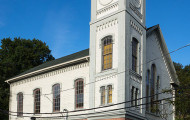Anna Strother serves as a soloist at Congdon Street Baptist Church
Anna Strother was a soloist at the Congdon Baptist Church, as reported by Lydia T. Brown in the Baltimore Afro-American on November 24, 1951. Brown describes Strother as a “dramatic soprano.”
Anna Strother
Based on census and newspaper records, the researchers believe that Anna Strother was likely born in Virginia, but had moved to Providence, RI at some point between her birth and the 1930s. According to census records in 1940, Anna was a domestic worker for the Baldridge family. But according to Lydia T. Brown, the "Yankee Traveler" columnist for the Baltimore Afro-American, Anna was a "dramatic soprano" who served as a soloist for a local church and performed for a local benefit concert in November 1951.
--written by Lydia Kelow-Bennett
Learn more
Congdon Street Baptist Church
The history of the Congdon Street Baptist Church reflects much of the racial history of Providence through the 19th and 20th centuries. The church was first located on Meeting Street, when Moses Brown deeded the street to "People of Color" in 1819. In 1820, the African Union Meeting House and School was officially established. The church stayed at this location until 1869, when neighbor George Hale asked the church to exchange their property for property he owned on Congdon and Angell streets. The church indicated that they were not interested in moving for financial reasons (they had no debt in this location). Shortly thereafter, the church was burned to the ground. In 1874, the members of the church agreed to exchange property with Hale, and moved to the present-day Congdon Street location. The church was then renamed Congdon Street Baptist Church. Congdon Street Baptist Church has remained a site for important local events, including housing the 65 black Brown University students who walked off the Brown Campus in 1968 in protest of Brown's failure to earnestly recruit qualified black students. Throughout its 20th century, Congdon remained a space for artists and local artistic practices.
--written by Lydia Kelow-Bennett
Learn more
